ENERGY AND TIME
- GOAL:
- To be aware of the different forms of energy and the time frame necessary for the development of these energy forms.
- OBJECTIVE:
- 1. The student will become familiar with different forms of energy.
- 2. The student will understand the sources of energy.
- 3. The student will acquire an understanding of the history of various sources of energy.
- LESSON / INFORMATION:
- Are energy sources renewable or nonrenewable? You can decide for yourself. If a source of energy is replaced as we use it, so that we can never use it up, it is called renewable. If there is a definite, limited supply of a source of energy, and it cannot be replaced, it is called nonrenewable. This is an important idea, because it helps us to decide how we should use each of our many sources of energy.
- Energy is all around us and comes from many sources. One of the most important sources of energy is the sun. The energy of the sun is the original source of most of the energy found on earth.
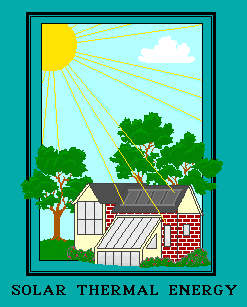
- We get solar heat energy from the sun, and sunlight can also be used to produce electricity from solar (photovoltaic) cells.
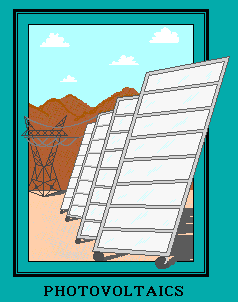
- The sun heats the earth's surface and the Earth heats the air above it, causing wind.
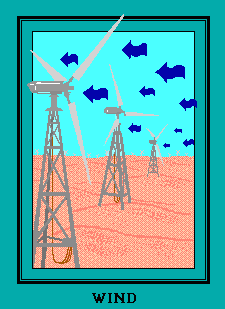
- Water evaporated by the sun forms clouds and rain to give us flowing streams and rivers. Both wind and flowing water (hydropower) are sources of energy.
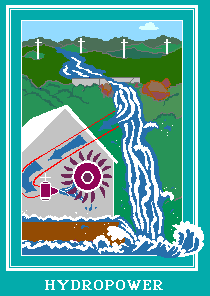
- So you see, the sun is the source of many kinds of energy found in nature. These kinds of energy are around us all the time. They are produced quickly, and replace themselves constantly as we use them. For this reason we say they are renewable.
- The sun's energy can also be stored. Plants store energy from the sun as they grow. Fruits, vegetables and wood from trees, for example, all contain stored solar energy. We call it biomass energy, from "bio" for "life" or "living". These kinds of energy are also renewable, but of course it takes longer to grow a plant or a tree than it does to get heat directly from sunlight.
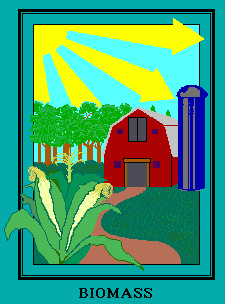
- When energy is stored in a material, we call that material fuel. Food and wood are biomass fuels. When you have old biomass that has become concentrated, you have what we call "fossil fuel".
- THE FORMATION OF FOSSIL FUELS
- Fossil fuels are found deposited in rock formations. They were formed there between 350 million and 50 million years ago. The processes by which they were formed are not totally understood. Decayed remains of ancient plants and/or animals were buried by sediments. Through the action of heat and pressure over millions of centuries, they were chemically changed. Coal, oil, and natural gas are the results.
- Coal was formed from the remains of ferns, trees, and grasses that grew in great swamps 345 million years ago. These remains formed layers as they sank under the water of the swamps. The plant material partially decayed as these layers formed beds of peat, a soft brown substance that is up to 30% carbon. Peat is the earliest stage of coal formation.
- Shallow seas later covered the swamps and slowly deposited layers of sand and mud over the peat. These sediments exerted pressure on the peat over thousands of years. Slowly, chemical changes took place transforming it into lignite or brown coal, which is about 40% carbon. Millions of years later, increasing pressure and heat changed lignite into bituminous or soft coal (about 66% carbon) and finally into anthracite or hard coal (over 90% carbon).
- Oil and natural gas are also found in beds of sedimentary rock. The sediments were deposited by shallow seas millions of years ago. The remains of plants and animals living in the seas settled to the bottom and were buried under layers of sediment. These layers were subjected to heat and pressure over millions of years. The sediments were transformed into beds of rock, and the plant and animal remains underwent slow chemical change and formed oil and natural gas.
- As you can see, the fossil fuels take millions of years to form. They cannot be replaced quickly. In fact, in terms of our lifetime they cannot be replaced at all. For that reason we call them nonrenewable.
- OTHER ENERGY FORMS
-
- There are still other kinds of energy: ocean thermal energy, geothermal energy, and nuclear energy, for example. We cannot discuss all of them here, but your teacher can give you information about them.
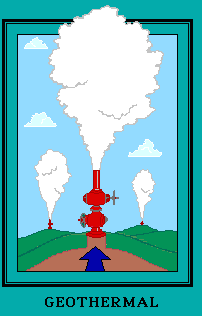
- A QUICK ENERGY HISTORY
- Pre 1700's
- The story of American life is an energy story. The first Americans, Native Americans, used their own muscle power to do work and to travel. They burned wood for cooking and heating. They used the sun's energy to dry food and animal skins.
- The 1700's
- When settlers came from Europe, they used these same kinds of energy, but they also used some new ones. They used wind power to drive the ships that brought them here. They used animal power to help with their work and travel. They also built mills that used water power to grind grain, saw wood and pump water. Wood was still their main fuel.
- The 1800's
- America's population grew. People wanted more food, faster travel, better clothing and shelter. The new steam engine could be used to run machines, ships, and trains, but it needed fuel. Factories and railroads grew, using more and more fuel. In some places, wood became scarce so coal began to replace wood. For lighting, coal gas and natural gas began to take the place of candles and whale oil. People learned to break down oil into products like kerosene for lighting and cooking. Then the automobile was invented. Soon a lot of oil would be needed to make gasoline for cars.
- The 1900's
- A greater dependence on electricity became apparent. Electric lights, appliances and machines made life easier for Americans. Coal, oil, natural gas and hydro (water) power were all used for making electricity. Then nuclear energy was discovered, and it was also used to make electricity.
- Americans used a lot of oil. We used it to make electricity, to make fuels for transportation and heating, and to make many products like plastic and nylon. The price of oil went up, and so did the prices of electricity and gasoline. The supplies are finite and continue to dwindle at an accelerated rate.
- People began to conserve energy. They began to use the kinds of energy that Native Americans and early settlers had used, energy from the sun, the wind, and wood. They also searched for new sources of energy, and new ways to use energy for the future.
- The 2,000's
- Predict the future in energy development in the 2,000's.
- __________________________________________________
- __________________________________________________
- __________________________________________________
- ACTIVITY 1:
- The graphs below give two different representations of our energy sources. They illustrate the same thing in different ways. The story they tell is the same story you have just read. Study them carefully, and then answer the questions.
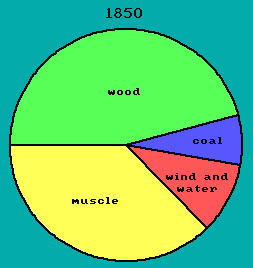
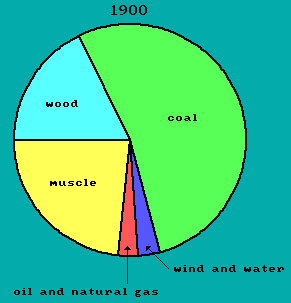
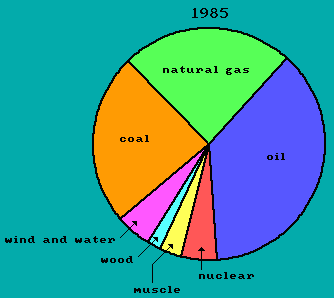
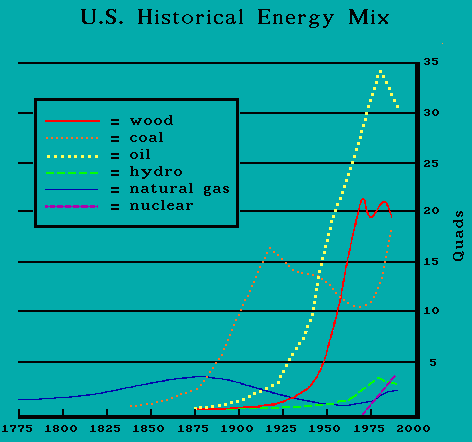
- Chart reprinted with permission from the New York Energy Education Handbook, New York State Dept. of Education.
- QUESTIONS:
- 1. What were the most important kinds of energy in the early days of America? What were they used for?
- 2. The American Revolution was in the 1770's. What was the most used fuel then?
- 3. The American Civil War was in the 1860's. What was the most used fuel then?
- 4. Why did coal become so important by 1900?
- 5. Why do you think it took so long for coal to replace wood as the most important fuel?
- 6. What was the most used fuel in 1975. What use did it have?
- 7. Why do you think oil use went down and wood use went up during the 1970's?
- 8. What sources of energy does the U.S. depend on most today?
- ACTIVITY 2:
- Match the pictures below with the correct titles.
- _____1. Solar Thermal Energy
- _____2. Biomass
- _____3. Hydropower
- _____4. Wind
- _____5. Geothermal
- _____6. Photovoltaic
- A

- B

- C

- D

- E

- F

- INFORMATION CHECK
- Directions:
- After studying the information provided, fill in the blanks below.
- The ______________ is the original source of almost all the energy on earth. Energy appears in many different forms, but if you trace it back far enough, you find that it all started at the same place: the ____________________.
- Some sources of energy exist in almost unlimited supply. As soon as we use some energy, it is replaced by more. For this reason, we say that these sources of energy are ________________________.
- Perhaps the "fastest" energy is ____________________ electricity, which is produced when sunlight strikes solar cells. These are the round, bluish wafers that are mounted on space satellites to give them electric power from sunlight when they are in space.
- It only takes the sun a few minutes to give us direct solar _________________. You can feel it in a car that sits in the sun. Houses and buildings can be designed to collect sunlight the same way. You can also build solar collectors to trap the sun's heat.
- The sun heats the earth and the earth warms the air above it. Heated air rises (just like a hot air balloon). When cooler air rushes in to displace the heated air, we have __________________. This energy can be used to sail ships or drive machines to pump water or produce electricity.
- The sun heats the surface water of lakes and oceans. Some of the water evaporates when it is heated. Then it forms clouds, falls as rain, and collects in lakes and rivers. As this water flows back to the sea it provides _________________ which can drive a turbine to generate electricity.
- The plants of the earth are solar collectors. By the process of photosynthesis, they use sunlight to produce stored chemical energy that is used for food or fuel. Plant energy is called _______________.
- Some sources of energy take so long to produce that if we use them up they can't be replaced. ______________________, _________________, and _________________ are like that. Dead plants and animals must decay for hundreds to millions of years to produce these fossil fuels. That is why we say they are _______________________________.
- RECOMMENDED READING:
- New York Energy Education Project, Research Foundation of the State University of New York. Albany, NY. 1985
- TEACHER'S NOTES
- DEFINITIONS:
- Are they renewable or nonrenewable? You can decide for yourself. If a source of energy is replaced as we use it, so that we can never use it up, it is called renewable. If there is a definite, limited supply of a source of energy, and it cannot be replaced, it is called nonrenewable. This is an important idea, because it helps us to decide how we should use each of our many sources of energy.
- Quad -
- A gigantic energy unit (often used to state how much energy entire countries buy each year). It represents a quadrillion Btu's, the amount of heat energy in 172 million barrels of oil; a unit of energy equal to one quadrillion Btu's (1,000,000,000,000,000).
- ANSWERS TO QUESTIONS:
- 1. Coal and wood were the most important energy sources in the early days of America.
- 2. The most used fuel during the 1770's was wood.
- 3. During the 1860's wood was still the most used fuel.
- 4. Coal became important just prior to 1900 because of its many uses such as the fuel for steam engines which powered the many railroad engines popular during the period, and fuel for the steam turbines used in the production of electricity. Coal also began to replace wood as a source of heat for commercial and residential buildings.
- 5. Wood remained the most popular fuel for a long period of time because of its abundance and the fact that it was extremely inexpensive.
- 6. Oil was the most important fuel in 1975. Fuel oil derived from oil became extremely important at this time due to the mobility of the world's people and the so called "Shrinking of the globe" by faster and faster means of transportation.
- 7. Oil went down due to energy conservation measures and the high price of fuel oil brought on by the Arab oil embargo.
- 8. The United States is still highly dependent on oil as its main source of energy. This is a serious problem due to its shrinking supply. Alternative sources such as atomic energy, natural gas and renewable sources need to be developed in the near future to avoid catastrophic consequences.
- ANSWERS TO ACTIVITY 2
- 1. = D
- 2. = B
- 3. = A
- 4. = E
- 5. = F
- 6. = C
- ANSWERS TO INFORMATION CHECK:
- The ____SUN_____ is the original source of almost all the energy on earth. Energy appears in many different forms, but if you trace it back far enough, you find that it all started at the same place: the ______SUN__________.
- Some sources of energy exist in almost unlimited supply. As soon as we use some energy, it is replaced by more. For this reason, we say that these sources of energy are ____RENEWABLE_______.
- Perhaps the "fastest" energy is _____SOLAR__________ electricity, which is produced when sunlight strikes solar cells. These are the round, bluish wafers that are mounted on space satellites to give them electric power from sunlight when they are in space.
- It only takes the sun a few minutes to give us direct solar ____ENERGY_______. You can feel it in a car that sits in the sun. Houses and buildings can be designed to collect sunlight the same way. You can also build solar collectors to trap the sun's heat.
- The sun heats the earth and the earth warms the air above it. Heated air rises (just like a hot air balloon). When cooler air rushes in to displace the heated air, we have ______WIND________. This energy can be used to sail ships or drive machines to pump water or produce electricity.
- The sun heats the surface water of lakes and oceans. Some of the water evaporates when it is heated. Then it forms clouds, falls as rain, and collects in lakes and rivers. As this water flows back to the sea it provides ___HYDROPOWER____ which can drive a turbine to generate electricity.
- The plants of the earth are solar collectors. By the process of photosynthesis, they use sunlight to produce stored chemical energy that is used for food or fuel. Plant energy is called ___BIOMASS_____.
- Some sources of energy take so long to produce that if we use them up they can't be replaced. _______COAL___________, ______OIL_______, and _____GAS_________ are like that. Dead plants and animals must decay for hundreds to millions of years to produce these fossil fuels. That is why we say they are ________NONRENEWABLE___________.
Comments or questions to: TechAsmt@LA.GOV
Return to Home Energy Menu




















